Goya’s Use of Language
For my project, I decided to expand and translate my midterm paper on Goya’s use of language in advertising. For the midterm, I did research on Goya’s history and how it became the large food brand that it is today through the use of different languages. I chose to expand on this topic because of popular demand from my peers as they were really interested in Goya and wanted to see more of it.
Introduction
The phenomenon of using multilingual strategies and products to target different groups of people is the focus of this paper. It’s important to understand this relationship between language and consumers’ choices in everyday life, like the simple task of going to the supermarket. Goya, for example, is a popular food brand with various products in supermarkets across the US, Spain, and the Dominican Republic. Why is it so popular, though? What is it about a brand like Goya that gives it popularity in supermarkets? How do they become such an essential part of consumers’ domestic food items?
Goya’s History
Goya first began as a company that targeted its local Hispanic population. It was founded in 1936 by Unanue Ortiz and his wife, Carolina, who were immigrants from Spain (“Watch This Before Buying” 0:15). They purchased the Goya name “from a Moroccan sardine-porter for $1” and began by selling authentic Spanish products such as olives, olive oil, and sardines from their storefront in Manhattan, NY (“Watch This Before Buying” 0:45).
After World War II in 1945, the surge of Puerto Rican immigrants led to Goya adding plantains, yuca, and pigeon peas to their product line (“Watch This Before Buying” 1:12). Further, more Cubans arrived in the 1950s, and Dominicans in the 1960s, which led to the addition of Goya’s black beans, guava paste, and coconut (Carlyle). This local targeted marketing strategy allowed the company to grow as Latinos from Mexico and Central America continued to immigrate and form a large population of potential customers (“Watch This Before Buying” 1:28). Goya’s beginning was focused on providing these Latino communities with good quality products that they used in their native countries. Therefore, their early advertisements were in Spanish (see Timeline section). This strong combination of marketing in Spanish and providing authentic products resulted in Goya’s success with the Latino population.
Expanding to Non-Latino Customers
The foundation that Goya built with the Hispanic community has boosted this company’s success. Goya is now the largest Hispanic food company in the US which can be found in the majority of bodegas, independent grocery stores, large chain supermarkets, and national club stores (“History – Our Company”). However, Goya also got popular as a result of expanding its target population (“History – Our Company”). In the 1980s to early 2000s, Goya began marketing in English in order to target both 2nd-generation Latinos and the broader American population that began showing interest in more ethnic cuisines (Carlyle). This strategy to cater to non-Latino populations was further expanded in 2005 when Goya hired an agency to focus on specific marketing strategies to reach non-Latinos (Carlyle). According to Goya, this was a 10-year plan and $500 million investment that was specifically designed to “reach new consumers and strengthen the Goya brand worldwide,” resulting in more English advertisements on a variety of Goya’s products (“History – Our Company”). The new ads had a blonde, blue-eyed mother using adobo to season her chicken, and another with an African-American mother making Goya yellow rice. These types of advertisements led to an increase in Goya’s revenue from just below $1 billion in 2010 to $1.3 billion by the end of 2012 in the targeted households (Carlyle). These marketing strategies continue to help Goya thrive as they use representation, English, and Spanish to appeal to a larger audience and attract diverse consumers.
Conclusion
Overall, what first began as a company that was meant to target the Hispanic population with items such as refried beans, seasonings, and cooking oil, has now caught the attention of non-Hispanic customers as well through an evolution of bilingual advertisements. Based on this research, it seems like Goya has the ability to evolve over the years and begin including other common languages spoken in the US (such as Chinese and Arabic) to reach a larger variety of consumers. A lot of Goya’s profit comes down to the strong relationship between language, food, and culture that is shown throughout their advertisements.
Visual Timeline of Goya’s Products & Advertisements:
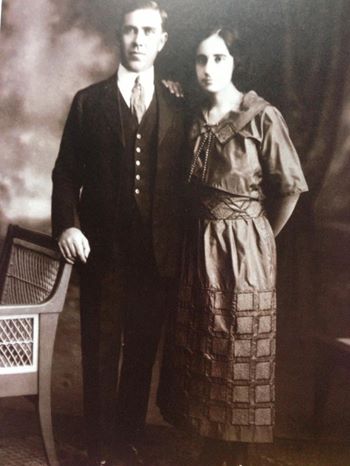
1936
Unanue & Carolina Ortiz founded Goya.
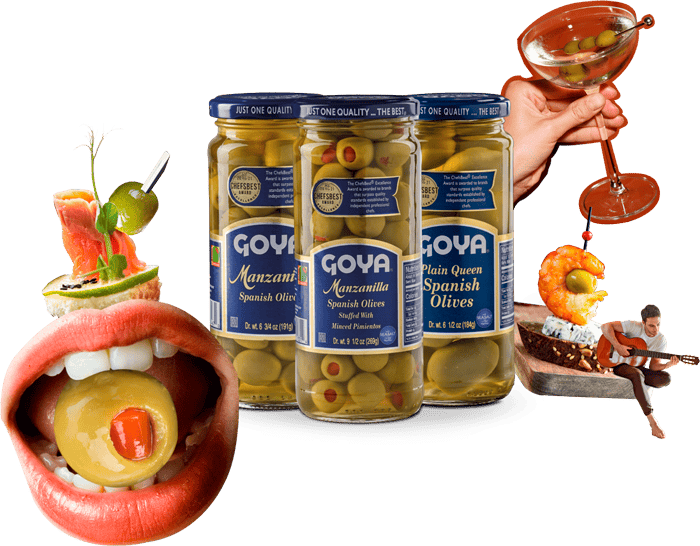
Began by selling mainly olives, olive oil, and sardines from their storefront in Manhattan, NY.
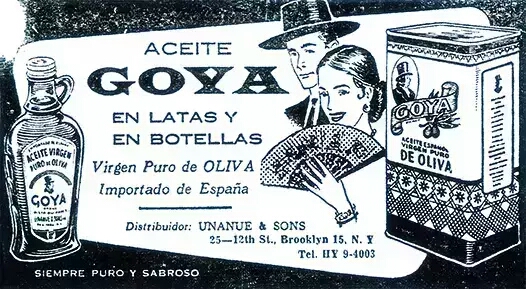
One of Goya’s first advertisements for olive oil was from the late 1930s.
Translation:
“Goya Oil, in cans and bottles. Pure virgin olive oil imported from Spain.
Always pure and tasty.”
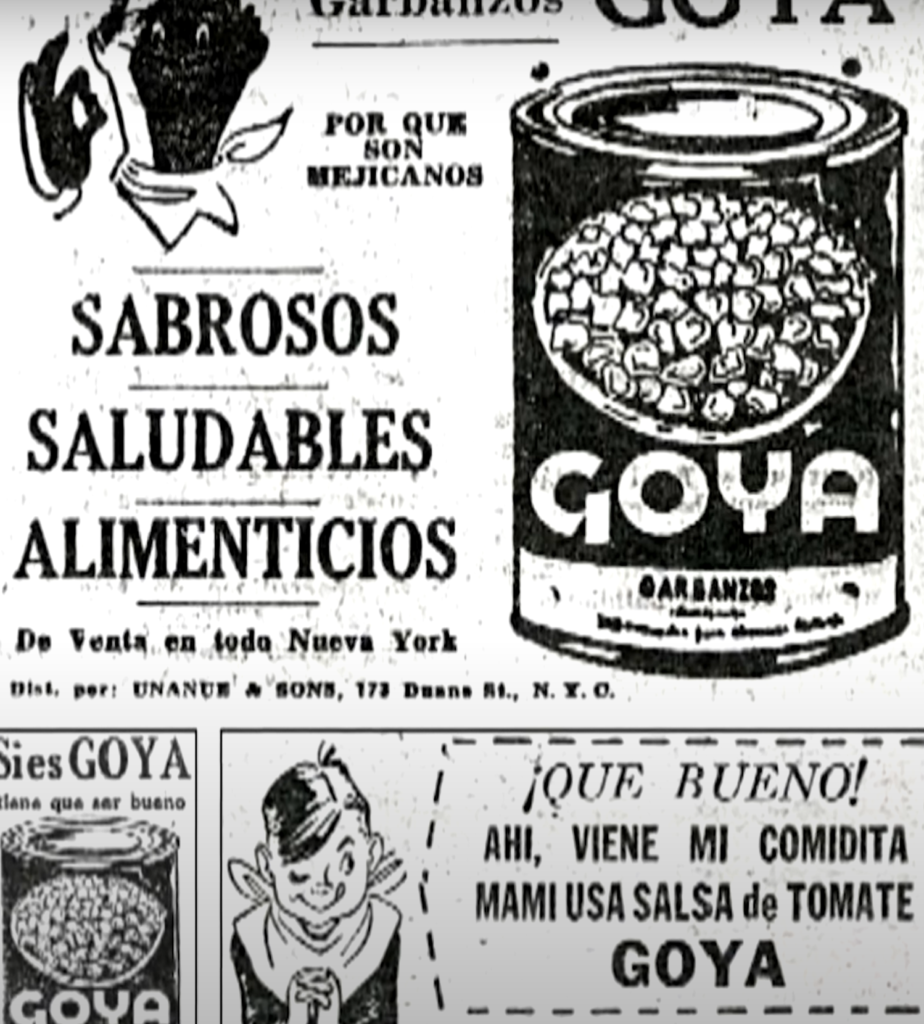
Another early Goya advertisement for their garbanzo beans.
Translation:
“Because they’re Mexican.
TASTY, HEALTHY, NOURISHING
For sale in all of New York.”
1945
Plantains, yuca, and pigeon peas were added to Goya’s product line.
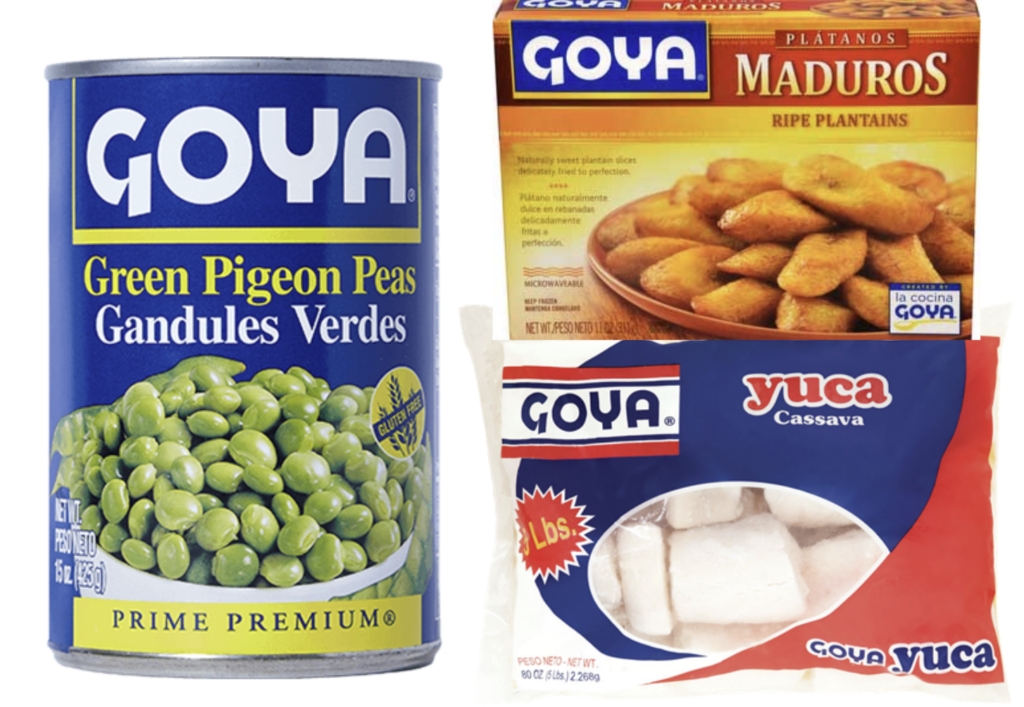
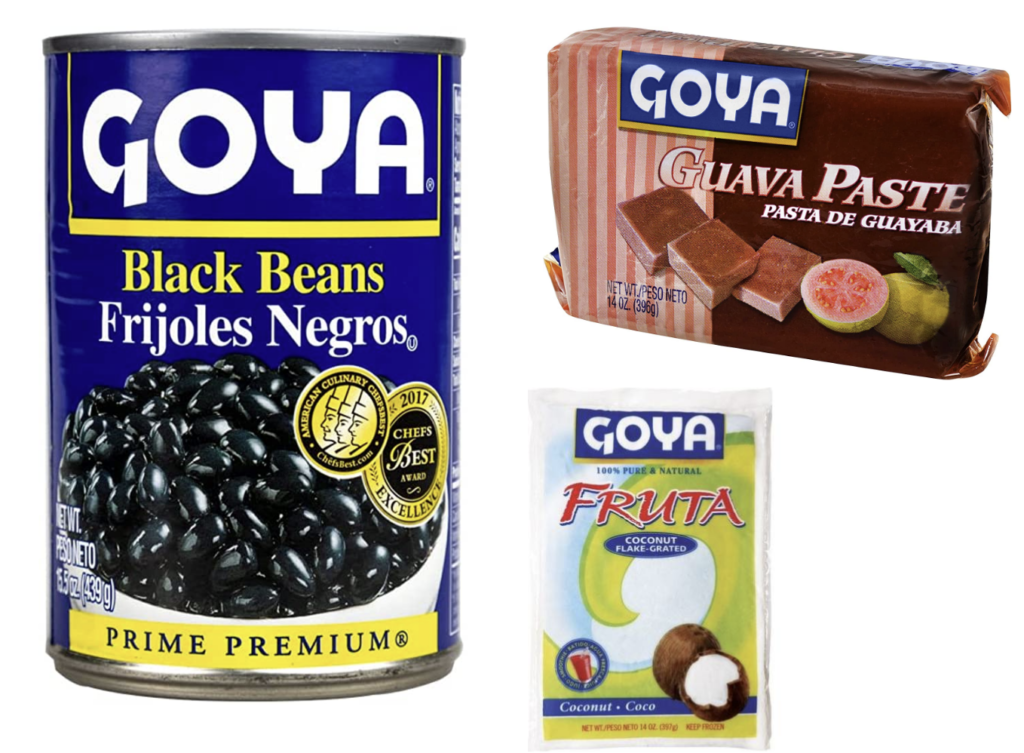
1950s & 1960s
Black beans, guava paste, and coconut added to Goya’s product line.
Goya begins adding English advertisements to their marketing strategy.
Goya’s well-known ad with a blue-eyed mother using adobo to season her chicken as a result of their 2005 marketing plan.
Another well-known ad with an African-American mother making Goya yellow rice was also made as part of Goya’s 2005 marketing plan.
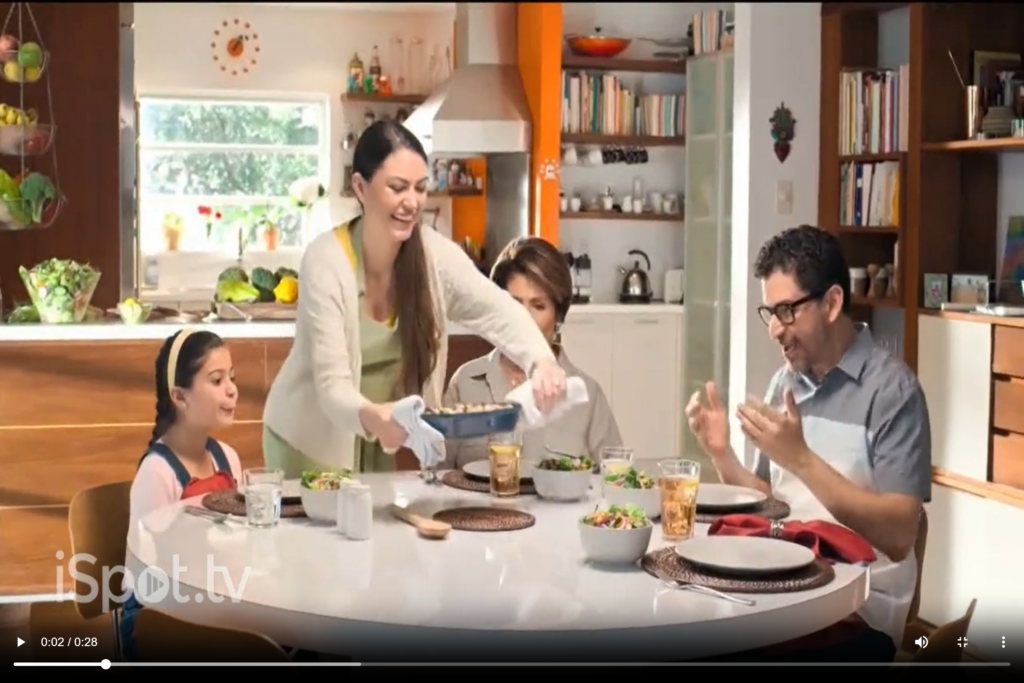
2019 – An example of a bilingual ad, mainly in Spanish with a couple of English words included (“what” and “beans’) focuses on family and dialect (“Goya Foods TV Spot”). This ad shows people from different countries saying the word “beans” in their dialect, such as “frijoles” and “habichuelas.” This further portrays that no matter how diverse the Latino community is, Goya is able to cater to all of them in an inclusive way. There is also a family component to this advertisement, which further connects culture and values with the ad’s use of language.
Translation of Bilingual ad:
“They say that whoever knows one Latino knows what they’re all like. That all we think about is soccer.
‘Dad, I want to play hockey.’ Well, there are exceptions.
Physically identical. The language is the same.
‘What is this?’ *Different people say the word ‘beans’ in their own dialect.* ‘What?’ Ha, totally the same.
It’s because we are a delicious mix that makes us unique. Because there are no two recipes that are the same. Your life, your recipes. Add the best to your recipes. If it’s Goya, then it has to be good!”
0:00 “If you want to connect to your roots,
0:02 you don’t need the latest Smartphone, you need
0:05 the Goya empanada discs
0:09 because I can add the things I like the most,
0:11 they are very easy to use,
0:15 crunchy, and I can make the empanadas
0:18 the way my mom showed me.
0:20 Goya empanada discs are so good that your
0:23 phone won’t stop ringing with others asking for
0:25 the recipe.
0:26 If it’s Goya, it has to be good.”
December 2022 (Discos & Garbanzos commercials)
Goya continues to produce Spanish, English, and bilingual ads to reach their audience. They also use emotional techniques to sell their products to Latinos as they claim that their product is “just like your mother’s recipe” (authentic). This aspect of authenticity also catches non-Latinos’ attention because they feel as though they are experiencing new cuisine from different countries right in their home.
My Process
Translating this essay into Spanish was mostly easy since I knew a lot of the information from my research. Therefore, it was easy to think about the topic in Spanish and know what vocabulary to use for each paragraph. I translated this essay paragraph by paragraph by looking at the two tabs side by side. However, it was very difficult to figure out the accents because I don’t often write in Spanish, and I don’t know the correct grammar for essay writing in Spanish. Therefore, I had to use outside resources to double-check my accents (Spanish dictionary and my mother). Additionally, it took a long time to translate the video transcripts on the Spanish page. Because most of the advertisements I discussed are already in English, I didn’t have to translate that much on the English page. On the Spanish page, however, I had to translate four videos’ transcripts because they were all in English. I had never translated video transcripts before so it was difficult to figure out the right vocabulary and structure for these translations.
Works Cited
Carlyle, Erin. “How Goya Became One of America’s Fastest-Growing Food Companies.” Forbes, Forbes Magazine, 8 May 2013, https://www.forbes.com/sites/erincarlyle/2013/05/08/how-goya-became-one-of-americas-fastest-growing-food-companies/?sh=6e6296453bd9.
“Discos – Staying Connected.” YouTube, uploaded by GOYA Foods, 7 Dec. 2022, https://www.youtube.com/watch?v=wlA49dDSToU.
“Garbanzos – Neighbors.” YouTube, uploaded by GOYA Foods, 6 Dec. 2022, https://www.youtube.com/watch?v=W0bDsmGMTFU.
“Goya Adobo Commercial-Fall 2012.” YouTube, YouTube, 1 May 2013, https://www.youtube.com/watch?v=Xa_z1qNdy30.
“Goya Foods TV Spot, ‘Una Mezcla’.” ISpot.tv | Realtime TV Advertising Performance Measurement, 17 Sept. 2019, https://www.ispot.tv/ad/oxOL/goya-foods-una-mezcla-spanish.
“GOYA – ‘Yellow Rice.’” YouTube, YouTube, 3 Aug. 2012, https://www.youtube.com/watch?v=LtumQ4Tp58k.
“History – Our Company: Goya Foods.” Our Company | Goya Foods, https://www.goya.com/en/our-company/history.
“Watch This Before Buying More Goya Foods.” YouTube, uploaded by Mashed, 22 Aug. 2020, https://www.youtube.com/watch?v=u6BbrAdpRGk.
“Zohra Lampert for Goya Beans (1985).” YouTube, YouTube, 19 Aug. 2015, https://www.youtube.com/watch?v=GuLV3AzLT1k.